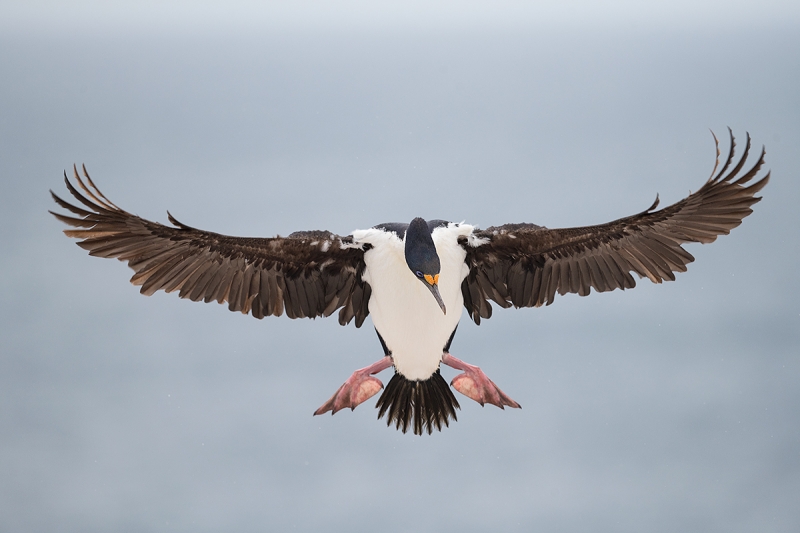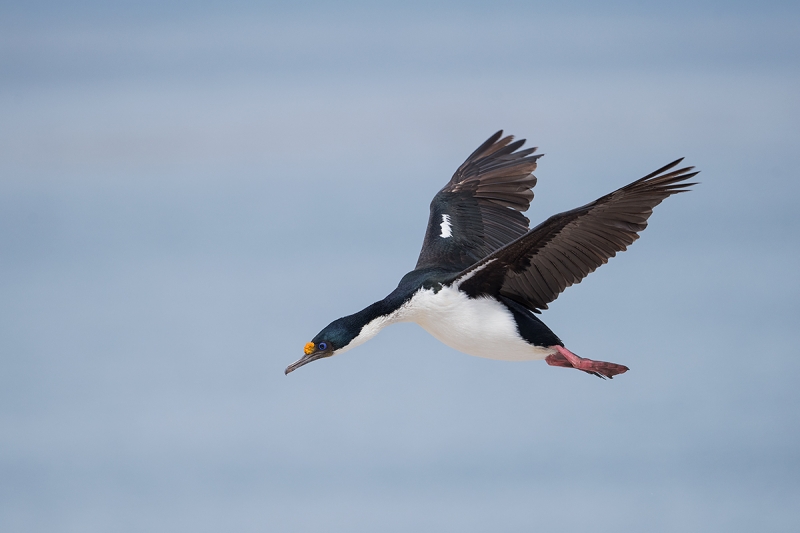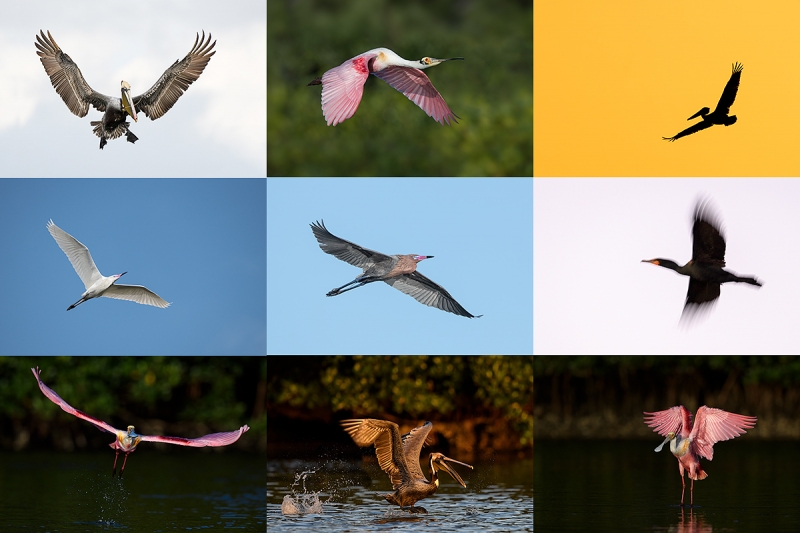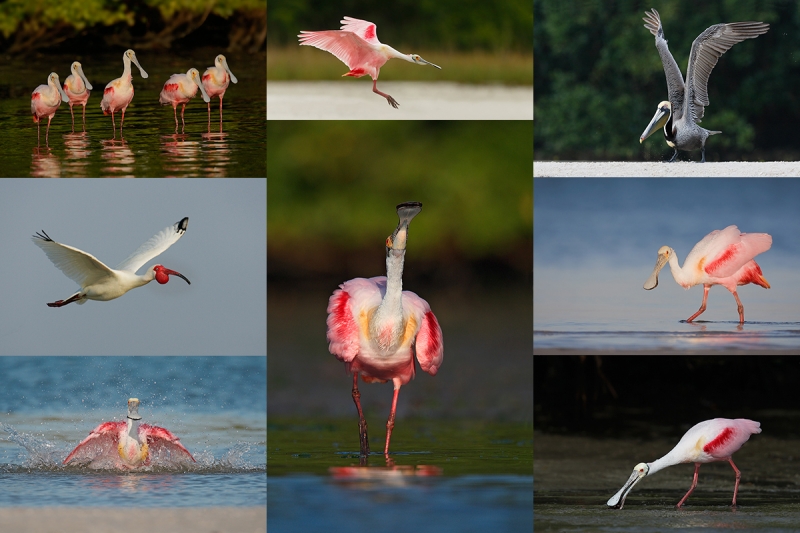What’s Up
I spent most of Sunday cooped up in my hotel room at the Santiago airport catching up in the Avian forum at BPN. The flight was scheduled to leave until 11:30pm but was delayed 30 minutes. I did not sleep much or comfortably on that red-eye flight … I had several hours to make my connection to Orlando and Jim picked me up at about 10:15am. After a stop in Publix, I was back to my home in ILE by 12:15. It felt good to be home. Did I mention that I fly to San Diego for the IPT this Friday? Yikes!
If …
If you missed Sunday’s My two very favorite images from the Falkland Land-based IPT: Scrambled Egg for Dinner and Yawning Albatross blog post here, please visit and let me know which of the two images is your favorite.
Very Interesting …
If you would like to read an interesting discussion that I had with my friend, BPN Avian moderator Isaac Grant, about the Nikon 80-400 VR check out panes 11, 15, and 18 in the BPN Avian post here.
IPT Updates
If you are interested in learning about the last-second San Diego late registration discount, please get in touch immediately via e-mail. I still need three or four folks for the Galapagos trip. If you would like to explore the possibilities, please get in touch via e-mail. No reasonable offer will be turned down.
- 2019 San Diego 4 1/2-DAY BIRDS AS ART Instructional Photo-Tour (IPT) SUN JAN 20, 2019 thru and including the morning session on THURS JAN 24: 4 1/2 days: $2099. (Limit: 10/Openings: 4) Introductory Meet and Greet at 7:00pm on the evening before the IPT begins: SAT DEC 19, 2019.
- The 2019 Hooptie Deux/Roseate Spoonbill Boat 3 1/2 DAY IPT — FEB 16 thru 19, 2019: $2599.00. Limit: 5 photographers/Openings: 2.
- The New, Expanded 2019 UK Puffins, Gannets, & Red Kites IPT. Thursday June 27 (from EDI) through Tuesday, July 9, 2019 (on the ground; fly home on Wednesday July 10.): $9,999. Limit 10 photographers/Openings: 9. This trip needs four to run. Co-leader: Peter Kes.
- The GALAPAGOS Photo Cruise of a Lifetime IPT/The Complete Galapagos Photographic Experience. July 23 to August 6, 2019 on the boat. 13 FULL and two half-days of photography: $14,499. Limit: 12 photographers/Openings: 4.
BIRDS AS ART
BIRDS AS ART is registered in the U.S. Patent and Trademark Office.
Selling Your Used Photo Gear Through BIRDS AS ART
Selling your used (or like-new) photo gear through the BAA Blog is a great idea. We charge only a 5% commission. One of the more popular used gear for sale sites charged a minimum of 20%. Plus assorted fees! Yikes. They went out of business. And e-Bay fees are now up to 13%. The minimum item price here is $500 (or less for a $25 fee). If you are interested please scroll down here or shoot us an e-mail with the words Items for Sale Info Request cut and pasted into the Subject line :). Stuff that is priced fairly — I offer pricing advice to those who agree to the terms — usually sells in no time flat. Over the past year, we have sold many dozens of items. Do know that prices on some items like the EOS-1D Mark IV, the old Canon 100-400, the old 500mm, the EOS-7D and 7D Mark II and the original 400mm DO lens have been dropping steadily. You can always see the current listings by clicking here or on the Used Photo Gear tab on the orange-yellow menu bar near the top of each blog post page.
Money Saving Reminder
If you need a hot photo item that is out of stock at B&H, would enjoy free overnight shipping, and would like a $50 discount on your first purchase, click here to order and enter the coupon code BIRDSASART at checkout. If you are looking to strike a deal on Canon or Nikon gear (including the big telephotos) or on a multiple item order, contact Steve Elkins via e-mail or on his cell at (479) 381-2592 (Eastern time) and be sure to mention your BIRDSASART coupon code and use it for your online order. Steve currently has several D850s in stock along with a Nikon 600mm f/4 VR. He is taking pre-orders for the new Nikon 500 P and the Nikon Z6 mirrorless camera body.
Gear Questions and Advice
Too many folks attending BAA IPTs and dozens of photographers whom I see in the field and on BPN, are–out of ignorance–using the wrong gear especially when it comes to tripods and more especially, tripod heads… Please know that I am always glad to answer your gear questions via e-mail. Those questions might deal with systems, camera bodies, accessories, and/or lens choices and decisions.
|
|
|
This image was created on December 29, 2018 on Bleaker Island, The Falklands. I used the hand Nikon AF-S NIKKOR 500mm f/5.6E PF ED VR lens and my souped up Nikon D850. ISO 1000. Matrix metering plus about 1 1/3rd stops off the sky: 1/2000 sec. at f/6.3 NATURAL AUTO WB at 4:44pm on a fortunately cloudy afternoon. Nikon Focus Peaking fine-tune value: +3. See the Nikon AF Fine-tune e-Guide here. Center Group (grp) AF point/Continuous (C in Nikon/AI Servo with Canon) AF was active at the moment of exposure. The array was centered just to our left of the bird’s head; that is about as good as I can do. The image is perfectly sharp on the eye. Image #1: Imperial (King or Blue-eyed) Shag (or Cormorant) braking to land |
Are You Loving Sun for Flight Photography?
There a 8,000 pairs of this species nesting in a single large colony just four minutes by truck from the lodge on Bleaker Island. Afternoons with the wind out of the west always provide non-stop flight photography action — shoot till your neck muscles ache and you can no longer raise your lens. After the introductory briefing, everyone in the group was really anticipating some excellent flight photography. On our first afternoon, the skies were pretty much clear and the wind was only about 20 degrees from lining up precisely with the sun. On the surface, conditions seemed ideal. But they were not. With a bird flying directly at us and the sun from over our right shoulders, the right side of the bird’s face was always in shadow. Evening out the exposure in these situations is always a challenge and creating a satisfactory master file is often impossible. Working with the 500 PF and the D5 I had a zillion super-sharp images but kept only a very few. Most or all of those will never be processed.
On our second afternoon, we enjoyed cloudy-bright conditions. We needed higher ISOs than we did the previous day, but the light was simply not strong enough to cause any shadows on the bird’s faces. I am not sure why I went to the D850 that afternoon but I was surely happy with the results. I kept dozens and dozens of very sharp on the eyes images. What a pleasure it is to hit Command Z in Photo Mechanic to enlarge each flight image and see that crisp purple eye ring.
The Lesson
Cloudy-bright conditions are often far better for flight photography than full sun …
|
|
|
This image was created also on December 29, 2018 on Bleaker Island, The Falklands and again I used the hand held Nikon AF-S NIKKOR 500mm f/5.6E PF ED VR lens and my souped up Nikon D850. ISO 800. Matrix metering plus about 1 stop off the sky: 1/2500 sec. at f/6.3 NATURAL AUTO WB at 4:10pm on a fortunately cloudy afternoon. Nikon Focus Peaking fine-tune value: +3. See the Nikon AF Fine-tune e-Guide here. One up from center Group (grp)/Continuous (C in Nikon/AI Servo with Canon) AF was active at the moment of exposure. The array was centered on the base of the bid’s neck, again about as good as I can do. The image was perfectly sharp on the eye. Image #2: Imperial (King or Blue-eyed) Shag (or Cormorant) incoming display pose |
The Incoming Display Pose
I have seen the incoming display pose in more than a few bird families including the cormorants (as seen in Image #2), terns, skimmers, and gannets. I am 100% positive that when the birds land with their wings swept back (and often with their tails pulled forward) that they are displaying to their mates. That even though some gannet researchers told me that I was wrong …
The Bird With at Least Six Names
The bird pictured in both of today’s featured images may go by any of the following common names: Imperial Cormorant, Imperial Shag, King Cormorant, King Shag, Blue-eyed Cormorant, or Blue-eyed Shag (all possibly Phalacrocorax atriceps). While you are at it you can throw in Antarctic Shag (Leucocarbo bransfieldensis) and South Georgia Shag (Leucocarbo georgianus). I think that the correct name for the species you are looking at is often determined by which side of the bed a given research or ornithologist got out of the bed on or what they had for breakfast. The species (???) mentioned here are often lumped and or split. They all pretty much look the same.
The 500 PF
The hand held Nikon AF-S NIKKOR 500mm f/5.6E PF ED VR lens is by far the best lens for photographing birds in flight that I have ever used. As noted previously I used it a ton in the Falklands, sometimes with the D5 for flight, usually with the D850, and often with the TC-E14, the latter two for general bird and nature photography. Though I had the TC-E17 with me, I did not use it once on the trip.
Was every one of the thousands of cormorant flight images that I created razor sharp on the eye? No, of course not. Most of the time unsharpness is caused by either of these:
- 1-Operator error. Either I failed to get AF tracking properly because of poor hand eye coordination and/or declining fine motor skills or I simply did not have the Group array on the bird’s face, neck, or upper breast. Note: Fine motor skill (or dexterity) is the coordination of small muscles, in movements — usually involving the synchronization of hands and fingers with the eyes.
- 2-The bird was much too large in the frame. In these cases, the Nikon AF system often picks up a part of the bird that is not on the same plane as the face and the eye.
Getting a 500 PF. Or not.
Right now it is close to impossible to get your hands on a 500 PF as the demand is huge and the supply is miniscule. BAA blog subscriber Gloria Matyszyk was able to secure one as a present for her husband from Steve Elkins at Bedford Camera. She originally made contact with him through the blog as detailed in most blog posts in the Money Saving Reminder feature (see above).
She wrote via e-mail:
I did receive the Nikon 500mm PF from Bedford just after Christmas for my hubby Dick Caldwell. We both loved it so much that we ordered another one for me! And yes, once again I entered the BIRDSASART coupon code on my online order. Thanks for putting me in touch with Bedford Camera. And welcome home in a few days! Gloria
Your chances of getting a 500 PF are greatly increased if you are an NPS member; if you are, please e-mail me for more info on getting yourself a 500 PF. If not, please order yours asap either through Bedford or by using my B&H affiliate link:
Nikon AF-S NIKKOR 500mm f/5.6E PF ED VR lens
|
|
|
From left to to right clockwise back to the center: Brown Pelican, Roseate Spoonbill downstroke, Brown Pelican sunrise silhouette, Double-crested Cormorant pre-dawn blur, Roseate Spoonbill flapping after bath, Brown Pelican taking flight, Roseate Spoonbill taking flight, Reddish Egret white morph breeding plumage in flight, and Reddish Egret dark morph breeding plumage in flight. All images on this card were created by me on the Hooptie Deux at Alafia Banks on the February 2018 trip.You can click on each card to enjoy a larger version. |
2019 Hooptie Deux/Roseate Spoonbill Boat 3 1/2 DAY IPT — FEB 16 thru 19, 2019: $2599.00. Limit: 5 photographers/Openings: 1.
3 1/2 days on the boat including four morning photo sessions and three afternoon sessions via customized pontoon boat.
Price per day Reduced from the 2018 rates! Please e-mail for details on IPT veteran and couples’ discounts. Pro-rated options may be available …
We will be leaving the dock very early for the morning sessions (weather permitting) in hopes of photographing the pre-dawn American Crow and White Ibis blast-offs. All sessions are planned for the Alafia Banks Roseate Spoonbill Rookery. We might consider other options in the unlikely event of horrific weather. There will be lots of opportunities for flight photography of several species including and especially Roseate Spoonbill. Also likely for flight photography are nesting Brown Pelican, both morphs of Reddish Egret, Great Blue Heron, Great Egret, White and Glossy Ibises, and Double Crested Cormorant. We should have some good chances with birds carrying nesting material. This IPT includes all boat and guide fees, in the field instruction, chest waders (feel free to bring your own of course to assure a perfect fit), and three working lunches on Saturday, Sunday, and Monday. For the most part we will be standing in mid-calf to knee high water behind our tripods. We help you get in and out of the boat with your gear. This is likely not the best trip for folks with mobility or balance problems. Note however that some folks opt to stay on the boat to photograph. They usually have lots of chances for flight photography of spoonbills and other species but are almost always pretty far away from the spoonbills that land.
|
|
All images on this card were created by me on the Hooptie Deux at Alafia Banks |
The Timing and Tides are Perfect!
I recently saw a similar trip advertised two months too late for breeding plumage spoonbills … The 2019 Hooptie Deux/Roseate Spoonbill Boat 3 1/2 DAY IPT represents an incredible opportunity to photograph Florida’s most wanted species. I do hope that you can join us. There will be a meet and greet at 7:00pm sharp on the evening of Friday February 15, 2019. All of the images on the card were made on the Hooptie Duex during the last two weeks of February, prime time for the spoonies in mega-breeding plumage. Many folks have written expressing interest so please do not tarry.
Please e-mail to hold your spot. Then you may either secure your spot by calling Jim or Jennifer at the office at 863-692-0906 and leaving the $500 deposit on credit card or sending your check for payment in full to us as follows with the check made out to:
BIRDS AS ART and sent here via US mail:
BIRDS AS ART
PO BOX 7245
Indian Lake Estates, FL 33855
If you call to leave your deposit you will be asked to mail your check for the balance no later than December 15, 2018.
|
Images courtesy of our guide; copyright 2017 Captain James Shadle (aka Froggie). All of the images here were created at Alafia Banks. Card creation and design by Arthur Morris/BIRDS AS ART. |
Everybody Loves Spoonbills!
Roseate Spoonbill is one of if not the most sought after avian photographic subjects in Florida. They are generally hard to find and somewhat difficult to approach. They are relatively easy to find at Alafia Banks—heck, you can’t miss seeing them, but even there they can on some days be somewhat difficult to approach. On some days we may be able to get ridiculously close to them. The huge incentive to get out to Alafia Banks in mid-February is the chance to photograph this species at the height of its spectacular breeding plumage…. with long telephoto lenses. A 500 or 600 with a 1.4X TC is perfect for this trip.
Mornings to Alafia Banks for spoonbills and Brown Pelicans (with lots of flight photography often with the birds likely carrying nesting material), Double-crested Cormorants, ibises (both Glossy and White) in breeding plumage. Some of the White Ibises may be sporting their spectacular, distended, red, naked (un-feathered) throat pouches—typically larger in the females. In addition we may get to photograph egrets including Great and Reddish, both in full breeding plumage, shorebirds, and more. There will be lots of flight photography opportunities. Afternoon trips will most likely be back to Alafia Banks for the spoonbills with an option to visit a more sheltered inland rookery location for a variety of nesting birds. In the event of horrific weather artie will either take the group to Fort DeSoto or will conduct an extensive image review/Photoshop session. This IPT includes lunches on the full days with small group image sharing and review and some over-the-shoulder Photoshop instruction.
Help Support the Blog
Please help support my efforts here on the blog by remembering to click on the logo link above each time that you shop Amazon. That would be greatly appreciated. There is no problem using your Prime account; just click on the link and log into your Prime account. With love, artie
If In Doubt …
If in doubt about using the BAA B&H affiliate link correctly, you can always start your search by clicking here. Please note that the tracking is invisible. Web orders only. Please, however, remember to shoot me your receipt via e-mail.




Please Remember to use my Affiliate Links and to Visit the New BAA Online Store 🙂
To show your appreciation for my continuing efforts here, we ask, as always, that you get in the habit of using my B&H affiliate links on the right side of the blog for all of your photo and electronics purchases. Please check the availability of all photographic accessories in the New BIRDS AS ART Online Store, especially the Mongoose M3.6 tripod head, Wimberley lens plates, Delkin flash cards and accessories, and LensCoat stuff.
As always, we sell only what I have used, have tested, and can depend on. We will not sell you junk. We know what you need to make creating great images easy and fun. And please remember that I am always glad to answer your gear questions via e-mail.
I would of course appreciate your using our B&H affiliate links for all of your major gear, video, and electronic purchases. For the photographic stuff mentioned in the paragraph above, and for everything else in the new store, we, meaning BAA, would of course greatly appreciate your business. Here is a huge thank you to the many who have been using our links on a regular basis and those who will be visiting the New BIRDS AS ART Online Store as well.
Be sure to like and follow BAA on Facebook by clicking on the logo link upper right. Tanks a stack.
Typos
In all blog posts and Bulletins, feel free to e-mail or to leave a comment regarding any typos or errors. Just be right :).



















I also prefer the second image — it’s crisp, sharp, and contrasty, and the bird really stands out from the pleasingly soft, creamy background. The bird is also in a graceful pose, as opposed to the first image, in which the bird appears clumsy and disheveled — almost embarrassing!
Love the second image. The birds pose with diagonal composition and the beautiful clean blue background. Top notch!